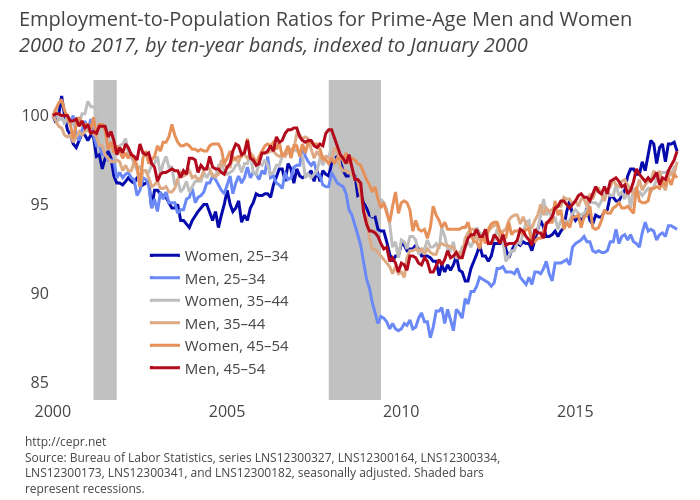January 05, 2018
January 5, 2018 (Jobs Byte)
By Dean Baker
The annual rate of wage growth over the last three months, compared to the prior three, was just 1.7 percent
The Bureau of Labor Statistics reported slightly weaker than expected job growth in December, with the economy adding 148,000 jobs. There was a modest downward revision to the data for the prior two months, which brought the three-month average to 204,000. The unemployment rate remained unchanged at 4.1 percent for the third consecutive month.
The best news in this report was the drop in the unemployment rate for blacks to 6.8 percent, the lowest since these data were first collected in 1972. The previous low was 7.0 percent in April of 2000. This is consistent with the view that a low unemployment rate disproportionately benefits the most disadvantaged groups. The black unemployment rate averages close to twice the white unemployment rate. This ratio has been reduced somewhat as the labor market tightened. The unemployment rate for whites in December was 3.7 percent.
Healthy job growth has continued to pull more prime-age workers (ages 25 to 54) into the labor market with the employment-to-population ratio (EPOP) edging up to 79.1 percent. This is a new high for the recovery, but it is still more than a full percentage point below its pre-recession level and 2.8 percentage points below the peak high in 2000.
It is worth noting that the EPOPs of varying demographic groups have not followed a predictable pattern since 2000. In the last recovery, women in the 25-to-34 age group showed the sharpest falloff in EPOPs. At present, they are one of the groups closest to recovering their 2000 EPOP. While men in the 25 to 34 grouping now show the sharpest falloff in EPOPs among prime-age workers, their EPOPs pretty much moved with the EPOPs for other prime-age workers in the last recovery. This suggests caution in assuming that changes in these EPOPs are due to supply-side issues as opposed to the strength of the labor market.
In this respect, it is worth noting that less-educated workers continue to be the biggest gainers from the continuing expansion. The EPOP for workers with just a high school degree has risen by 0.6 percentage points over the last year. For workers without a high school degree it has risen by 0.5 percentage points. By contrast, for workers with a college degree it is unchanged.
Other news in the household survey was mixed. All the duration measures of unemployment fell, with the average and median duration hitting new lows for the recovery, albeit still slightly higher than pre-recession levels. On the other hand, the percent of unemployment due to voluntary quits edged down to 10.9 percent. By comparison, it was over 13.7 percent in 2000.
On the payroll side, a disproportionate share of the job growth occurred in the goods-producing sector with construction adding 30,000 jobs and manufacturing adding 25,000 jobs. Employment in the mining and logging sector overall was unchanged, although coal mining lost jobs for the third consecutive month.
Health care added 31,400 jobs and restaurants added 25,100 jobs, both in line with their averages over the last year. The professional and technical services lost 4,700 jobs, the first decline in more than two years. This was driven by a loss of 15,400 jobs in accounting, a decline that is sure to be reversed as a result of the new tax law. The big loser was retail, which lost 20,300 jobs. Employment in the sector is down by 66,500 over the last year or 0.4 percent.
The most troublesome item in this report is the continued weakness of wages. The average hourly wage rose 2.5 percent over the last year, but this may actually be slowing. The annual rate for the last three months compared with the prior three months has been just 1.7 percent.
The weakest wage growth has been in manufacturing, where wages have risen by just 1.6 percent over the last year, and mining and logging, where the increase has been just 0.3 percent. This is consistent with production shifting from higher-paying union sites to lower paying non-union sites. Wages in retail have risen by a weak 2.1 percent, while in accommodation and food services they have risen by 3.6 percent, likely reflecting the impact of higher minimum wages.
On the whole, this is a positive report, but it certainly indicates no basis for concern about the labor market overheating.







